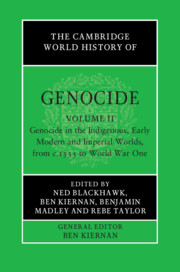Book contents
- The Cambridge World History of Genocide
- The Cambridge World History of Genocide
- The Cambridge World History of Genocide
- Copyright page
- Contents
- Figures
- Maps
- Tables
- Contributors to Volume ii
- Introduction to Volume ii
- Part I Settler Colonialism
- Part II Empire-Building and State Domination
- Part III Nineteenth-Century Frontier Genocides
- 15 The Genocidal French Conquest of Algeria, 1830–1847
- 16 ‘The Bloody Ground’
- 17 ‘A War of Extermination’
- 18 Lessons from Canada
- 19 Frontier Massacres in Australia, 1788–1928
- 20 Genocide in Van Diemen’s Land (Tasmania), 1803–1871
- 21 Genocide in Northern Australia, 1824–1928
- Part IV Premonitions
- Index
16 - ‘The Bloody Ground’
Nineteenth-Century Frontier Genocides in the United States
from Part III - Nineteenth-Century Frontier Genocides
Published online by Cambridge University Press: 23 June 2023
- The Cambridge World History of Genocide
- The Cambridge World History of Genocide
- The Cambridge World History of Genocide
- Copyright page
- Contents
- Figures
- Maps
- Tables
- Contributors to Volume ii
- Introduction to Volume ii
- Part I Settler Colonialism
- Part II Empire-Building and State Domination
- Part III Nineteenth-Century Frontier Genocides
- 15 The Genocidal French Conquest of Algeria, 1830–1847
- 16 ‘The Bloody Ground’
- 17 ‘A War of Extermination’
- 18 Lessons from Canada
- 19 Frontier Massacres in Australia, 1788–1928
- 20 Genocide in Van Diemen’s Land (Tasmania), 1803–1871
- 21 Genocide in Northern Australia, 1824–1928
- Part IV Premonitions
- Index
Summary
The Native peoples of North America long possessed a discourse critiquing the violent white invasion of their homelands. This Indigenous conscious of genocide—the belief that whites wanted Indian land and were willing to kill large numbers of Native men, women, and children in order to obtain it—profoundly shaped how Native nations responded in encounters with the new United States from the late eighteenth century onwards. Even in those cases where Indigenous peoples avoided the most extreme forms of violence, the awareness that they could become the targets of genocide still guided Native behavior. The asymmetrical nature of this violence demonstrates the need to stop labeling the nineteenth-century conflicts between the U.S. and Native nations as “Indian wars” and instead to embrace a language that stresses that these confrontations were unilateral colonial invasions of Indigenous homelands. Recentering historical analysis on the Indigenous conscious of genocide also demands greater attention to Native recordkeeping and perspectives, rather than privileging the intentions of the white perpetrators of genocide.
Keywords
- Type
- Chapter
- Information
- The Cambridge World History of Genocide , pp. 383 - 411Publisher: Cambridge University PressPrint publication year: 2023

